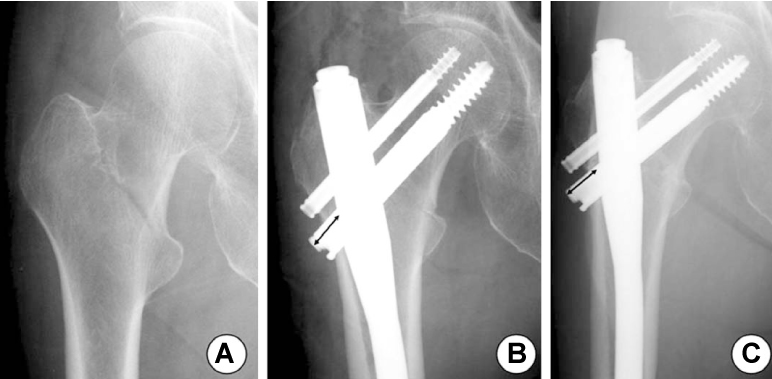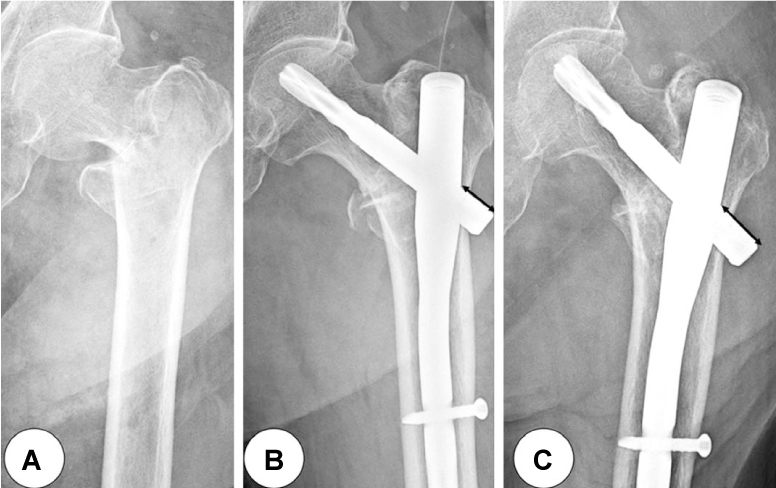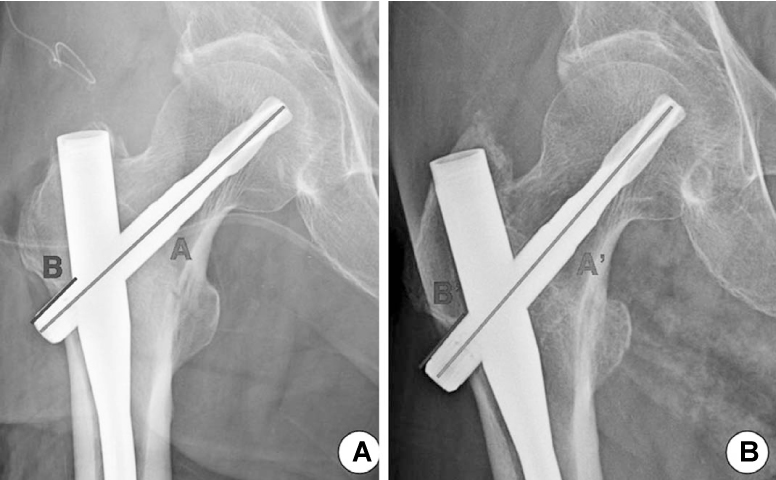J Korean Hip Soc.
2010 Mar;22(1):79-85. 10.5371/jkhs.2010.22.1.79.
PFNA and PFN in Intertrochanteric Fractures: Comparison Study of Sliding
- Affiliations
-
- 1Department of Orthopedic Surgery, Ilsan Paik Hospital, College of Medicine, Inje University, Koyang-si, Korea. osd11@paik.ac.kr
- KMID: 1461085
- DOI: http://doi.org/10.5371/jkhs.2010.22.1.79
Abstract
- PURPOSE
This study compared sliding between (a) lag screws of PFN (Proximal Femoral Nail, AO synthes) and (b) the helical blade of PFNA (Proximal Femoral Nail Antirotation, AO synthes) for femoral intertrochanteric fractures.
MATERIALS AND METHODS
We include in our study thirty seven cases who were classified as AO/OTA type A1 femoral intertrochanteric fractures and who underwent hip operations between October 2006 and December 2008. There were 19 patients in the PFN group and 18 in the PFNA group. Degrees of sliding were also measured with postoperative radiology on last follow up compared with immediate postoperative radiology. Both groups were also compared with regard too walking ability using the method of Koval.
RESULTS
Average sliding was 5.0+/-2.3 mm for lag screws of the PFN group and 2.8+/-1.3 mm for the helical blade of the PFNA group. The difference was statistically significant (p=0.04). Ambulatory abilities were not statistically different (p=0.33).
CONCLUSION
Patients in the PFNA group have less sliding of the implant, but their walking abilities are similar to patients in the PFN group.
Keyword
Figure
Cited by 1 articles
-
A Comparison of Intramedullary and Extramedullary Fixations for the Treatment of Reverse Oblique or Transverse Intertrochanteric Femoral Fractures
Yerl-Bo Sung, Jung-Yun Choi, Eui-Yub Jung
Hip Pelvis. 2012;24(2):109-116. doi: 10.5371/hp.2012.24.2.109.
Reference
-
1. Hwang DS, Rhee KJ, Choi JH. Recovery of walking ability after treatment of unstable intertrochanteric fractures in elderly patients: comparision of compression hip screw to primary hemiarthroplasty. J Korean Hip Soc. 1999. 11:22–29.2. Lee JY, Lee SY. Treatment of the proximal femoral extracapsular fracture with proximal femoral nail antirotation (PFNA): comparison with proximal femoral nail (PFN). J Korean Hip Soc. 2007. 19:183–189.
Article3. Richmond J, Aharonoff GB, Zuckerman JD, Koval KJ. Mortality risk after hip fractures 2003. J Orthop Trauma. 2003. 17:Suppl. 2–5.4. Evans EM. Trochanteric fractures: a review of 110 cases treated by nail-plate fixation. J Bone Joint Surg Br. 1951. 33:192–204.5. Madesen JE, Naess L, Aune AK, Alho A, Ekeland A, StrØmsØe K. Dynamic hip screw with trochanteric stabilizing plate in the treatment of unstable proximal femoral fractures: a comparative study with the Gamma nail and compression hip screw. J Orthop Trauma. 1998. 12:241–248.
Article6. Rha JD, Kim YH, Yoon SI, Park TS, Lee MH. Factors affecting sliding of the lag screw in intertrochanteric fractures. Int Orthop. 1993. 17:320–324.
Article7. Schipper IB, Marti RK, van der Werken C. Unstable trochanteric femoral fractures: extramedullary or intramedullary fixation.Review of literature. Injury. 2004. 35:142–151.
Article8. Strauss E, Frank J, Lee J, Kummer FJ, Tejwani N. Helical blade versus sliding hip screw for treatment of unstable intertrochanteric hip fractures: a biomechanical evaluation. Injury. 2006. 37:984–989.
Article9. Cleveland M, Bosworth DM, Thompson FR, Wilson HJ Jr, Ishizuka T. A ten-year analysis of intertrochanteric fractures of the femur. J Bone Joint Surg Am. 1959. 41:1399–1408.
Article10. Koval KJ, Skovron ML, Aharonoff GB, Meadows SE, Zuckerman JD. Ambulatory ability after hip fracture. A prospective study in geriatric patients. Clin Orthop Relat Res. 1995. 310:150–159.11. Hardy DC, Descamps PY, Krallis P, et al. Use of an intramedullary hip-screw compared with a compression hip-screw with a plate for intertrochanteric femoral fractures. A prospective, randomized study of one hundred patients. J Bone Joint Surg Am. 1998. 80:618–630.
Article12. Kyle RF, Wright TM, Burmstein AH. Biomechanical analysis of the sliding characteristics of compression hip screws. J Bone Joint Surg Am. 1980. 62:1308–1314.
Article13. Curtis MJ, Jinnah RH, Wilson V, Cunningham BW. Proximal femoral fractures: a biomechanical study to compare intramedullary and extramedullary fixation. Injury. 1994. 25:99–104.
Article14. Davis TR, Sher JL, Horsman A, Simpsion M, Porter BB, Checketts RG. Intertrochanteric femoral fractures. Mechanical failure after internal fixation. J Bone Joint Surg Br. 1990. 72:26–31.
Article15. Kim WY, Han CH, Park JI, Kim JY. Failure of intertrochanteric fracture fixation with a dynamic hip screw in relation to pre-operative fracture stability and osteoporosis. Int Orthop. 2001. 25:360–362.
Article16. Lee KB, Lee BT. Complications of femoral pertrochanteric fractures treated with proximal femoral nail (PFN). J Korean Fract Soc. 2007. 20:33–39.
Article17. Choo SK, Oh HK, Kim YC, Lee DB. Excessive sliding of compression hip screw for the treatment of intertrochanteric fracture in elderly. J Korean Hip Soc. 2007. 19:190–196.
Article18. Butt MS, Krikler SJ, Nafie S, Ali MS. Comparision of dynamic hip screw and gamma nail: a prospective, randomized, controlled trial. Injury. 1995. 26:615–618.
Article19. Halder SC. The Gamma nail for peritrochanteric fractures. J Bone Joint Surg Br. 1994. 74:340–344.
Article20. Simmermacher RKJ, Bosch AM, van der Werken C. The AO/ASIF-proximal femoral nail (PFN): a new device for the treatment of unstable proximal femoral fractures. Injury. 1999. 30:327–332.
Article21. Al-yassari G, Langstaff RJ, Jone JW, Al-Lami M. The AO/ASIF proximal femoral nail (PFN) for the treatment of unstable trochanteric femoral fracture. Injury. 2002. 33:395–399.
Article22. Im GI, Lee SH. Spontaneous extracorporeal extrusion of the lag screw from a proximal femoral nail. Injury Extra. 2006. 37:147–150.
Article23. Steinberg GG, Desal SS, Konwitw NA, Sullivan TJ. The intertrochanteric hip fractures. A retrospective analysis. Orthopedics. 1988. 11:265–273.
Article24. Lindskog DM, Baumgaertner MR. Unstable intertrochanteric hip fractures in the elderly. J Am Acad Orthop Surg. 2004. 12:179–190.
Article25. Park MS, Lim YJ, Kim YS, Kim KH, Cho HM. Treatment of proximal femoral fractures with proximal femoral nail antirotation (PFNA). J Korean Fract Soc. 2009. 22:91–97.
Article26. Yoo JH, Park JS, Non KC, Chung KJ, Kim HK, Kang JK, Hwang JH. The results of proximal femoral nail antirotation: a comparative study with proximal femoral nail. J Korean Hip Soc. 2008. 20:286–292.
Article
- Full Text Links
- Actions
-
Cited
- CITED
-
- Close
- Share
- Similar articles
-
- Treatment of the Proximal Femoral Extracapsular Fracture with Proximal Femoral Nail Antirotation (PFNA): Comparison with Proximal Femoral Nail (PFN)
- The Treatment of Unstable Intertrochanter Fracutures of Femur: Comparison between Proximal Femoral Nail and Dynamic Hip Screw
- Proximal Femoral Nail Antirotation and Proximal Femoral Nail in Intertrochanteric Fractures
- Excessive Sliding of the Helical Blade and the Femoral Neck Fracture after Insertion of Proximal Femoral Nail Anti-Rotation for Type A2 Intertrochanteric Fractures - A Case Report -
- Treatment of Intertrochanteric Fracture: Comparison of Proximal Femoral Nail and Proximal Femoral Nail A




